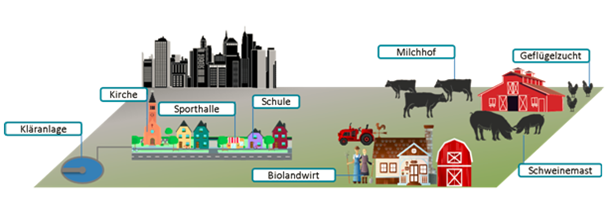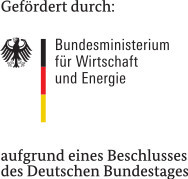SmartFarm2
| Working Group: | WG Optimization and Optimal Control |
| Leadership: |
Prof. Dr. Christof Büskens ((0421) 218-63861, E-Mail: bueskens@math.uni-bremen.de )
Dr.-Ing. Francesca Jung Lars Kappertz ((0421) 218-63870, E-Mail: kappertz@uni-bremen.de) |
| Processor: |
Viacheslav Solovievskyi (E-Mail: viacheslav.solovievskyi@stw.de)
Annika Hackenberg Lars Kappertz ((0421) 218-63870, E-Mail: kappertz@uni-bremen.de) Dr.-Ing. Eva Dierkes (E-Mail: eva.dierkes) |
| Funding: | Bundesministerium für Wirtschaft und Energie |
| Project partner: |
nD-enerserve GmbH Q3 ENERGIE GmbH & Co. KG |
| Time period: | 01.02.2021 - 31.08.2024 |
 Renewable energies are among the most important sources of electricity in Germany, and their expansion is a central pillar of the energy transition. In 2020, more than 50% electricity from renewable energy sources was fed into the grids for the first time.
The use of renewable energies goes hand in hand with a high demand for land, which is why rural areas in particular are seeing an increase in RE plants. This results in new structures for the actors - farmers become energy hosts, for example.
However, for the first photovoltaic (PV) plants, the legally guaranteed remuneration under the Renewable Energy Sources Act (EEG) expired at the end of 2020, as this is only valid for 20 years per plant. The subsidy will also cease for the first wind turbines. However, it is desirable to continue operating the old PV and wind plants after the statutory remuneration obligations have expired, not only in order to be able to use the energy produced. For operators of such plants, it may well be worthwhile to switch to self-consumption.
The SmartFarm2 project aims to identify potential for optimising self-consumption and to implement it in an exemplary manner. To this end, a test field with 101 real demonstrators (dairy farms, pig farms, greenhouses, schools, etc.) is to be equipped with very easy-to-handle sensor technology from the participating small and mid-sized Enterprise (SMEs) in order to record the hitherto unavailable high-resolution time-of-day-dependent consumer and producer data. Based on this data, the economic potential of self-consumption optimisation can be demonstrated with the help of AI methods and mathematical optimisation algorithms. Based on this, a highly automated energy management system (EMS) will then be developed.
Renewable energies are among the most important sources of electricity in Germany, and their expansion is a central pillar of the energy transition. In 2020, more than 50% electricity from renewable energy sources was fed into the grids for the first time.
The use of renewable energies goes hand in hand with a high demand for land, which is why rural areas in particular are seeing an increase in RE plants. This results in new structures for the actors - farmers become energy hosts, for example.
However, for the first photovoltaic (PV) plants, the legally guaranteed remuneration under the Renewable Energy Sources Act (EEG) expired at the end of 2020, as this is only valid for 20 years per plant. The subsidy will also cease for the first wind turbines. However, it is desirable to continue operating the old PV and wind plants after the statutory remuneration obligations have expired, not only in order to be able to use the energy produced. For operators of such plants, it may well be worthwhile to switch to self-consumption.
The SmartFarm2 project aims to identify potential for optimising self-consumption and to implement it in an exemplary manner. To this end, a test field with 101 real demonstrators (dairy farms, pig farms, greenhouses, schools, etc.) is to be equipped with very easy-to-handle sensor technology from the participating small and mid-sized Enterprise (SMEs) in order to record the hitherto unavailable high-resolution time-of-day-dependent consumer and producer data. Based on this data, the economic potential of self-consumption optimisation can be demonstrated with the help of AI methods and mathematical optimisation algorithms. Based on this, a highly automated energy management system (EMS) will then be developed.
Publications
- A. Hackenberg, L. Kappertz, S. Rapol, V. Solovievskyi, C. Büskens.
Optimal dimensioning of renewable energy generation and storage systems.
Energy Conversion and Management: X, Open access 24, Elsevier, 2024. - E. Dierkes, L. Kappertz, V. Solovievskyi, A. Hackenberg, C. Büskens.
Optimized Self-Consumption of Renewable Energies With Forecast-Based Energy Management for Agricultural Farms.
GAMM 94th Annual Meeting of the International Association of Applied Mathematics and Mechanics, 01.12.2024, Magdeburg, Germany.
- A. Hackenberg, L. Kappertz, S. Rapol, V. Solovievskyi, C. Büskens.
Optimal photovoltaic plant dimensioning using consumption data.
GAMM 92nd Annual Meeting of the International Association of Applied Mathematics and Mechanics , 15.08-18.08.2022.
Proceedings in Applied Mathematics & Mechanics, 23(1), Wiley, 2023.


